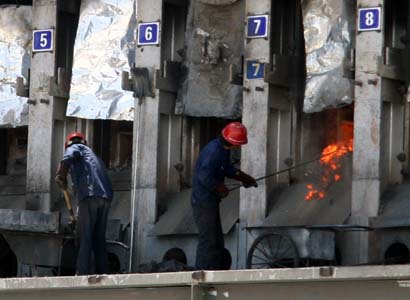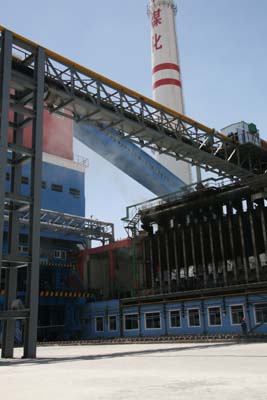| Sun Mountain: a new industrial town in the desert | ||
|
||
|
There is no mystery about what is attracting massive state-led investment to the Sun Mountain Development Area in Wuzhong Prefecture, Ningxia Hui Autonomous Region. Sun Mountain has something China needs very badly to feed the thundering beast of its economy: 14.6 billion tons of coal reserves lying under its rocky, arid desert. There are also 5 billion tons of limestone, nearly 2 billion tons of dolomite, and – a modern touch this – 300 days of wind power per year. But there is no doubt that King Coal, a tyrannical monarch who has devoured land and lives in Ningxia for the past 50 years, rules Sun Mountain. If China is to quench its thirst for electricity and industrial chemicals the old king will be on the throne for many years to come.

The road to Sun Mountain runs through scrubland and rocky desert dotted at precise intervals with the remains of the signal towers of the Great Wall. For miles the only signs of life are nomadic beekeepers parked at the roadside with twenty or thirty hives and a tent. Occasionally we spot the blackened, antique machinery of a small coal mine - the kind whose atrocious safety records make coal mining in China one of the most dangerous occupations on the planet. In a lower lying area there are one or two small villages, walls painted with slogans such as "Resolutely modernize agriculture" and, perhaps more helpfully, "Ring this number and an agricultural expert will be right by your side".
 What Sun Mountain lacks is as important as what it has, and its principal lack is water – a problem the authorities have solved by building a 120 kilometer pipeline from the Yellow River. The water is pumped up eight separate levels on its journey; the giant pipe steps up the gravel desert in giant segments delivering fifty thousand cubic meters of water every day to the newly constructed Liujia Gou reservoir, which has a capacity of 10 million cubic meters. A second phase due to begin construction in 2009 will add a further 10 million cubic meters. The problems do not end with the pumping. Mr. Wang Jijun, Sun Mountain's deputy director of business and investment, told us that 40 percent of the reservoir water is lost through evaporation. A short drive from the reservoir is the Sun Mountain Wind Power plant, operated by the Ningxia Power Generation Group. Phase one of the project, comprising 60 750 KW turbines, is complete and six further phases of construction are planned. Mr. Wang told us that the production cost of the electricity is twice that of a coal fired power station. But this is a commitment on the part of the government to look for cleaner, sustainable sources of energy. Despite its well-justified name, there are no plans for solar power generation at Sun Mountain. The technology is not yet economically viable according to Mr. Wang. A few meters from the sleek white turbines, road workers were breaking rocks with sledgehammers.
The first impressions of Sun Mountain's new urban area are of a suburban development in small-town America. The buildings have an almost cartoon-like quality – a brand new town hall with a clock tower, several shopping malls and blocks of low-rise housing, all built with the same red bricks. Hardly any of the buildings seem to be occupied as yet, but nearby a huge chemical plant operated by Inner Mongolia-based Qinghua Group, one of China's top 500 private companies, is already in production.
 Han Yong, deputy director of the development area, said the government's strategy is to develop Sun Mountain into a major energy and new materials base; that Sun Mountain will represent a major leap forward in Ningxia's development. The government has already invested 500 million yuan. A transformer substation and a reservoir have been completed, a high-speed expressway will open in October 2008, and a railway line to the provincial capital Yinchuan will be completed in 2010. Mr. Han said that 16 projects were started in 2007, including a coking plant, a methanol plant, a dimethyl ether plant and an oil well. The plants will all be based on new, clean technology with a particular emphasis placed on recycling and re-using waste materials. The small coal mines operating in the area will be closed and replaced with large modern mines. He said that the development area's population, currently less than 10,000 inhabitants is expected to increase to over 100,000 within 5 years. |
| Tools: Save | Print | E-mail |
|
| Comment |





